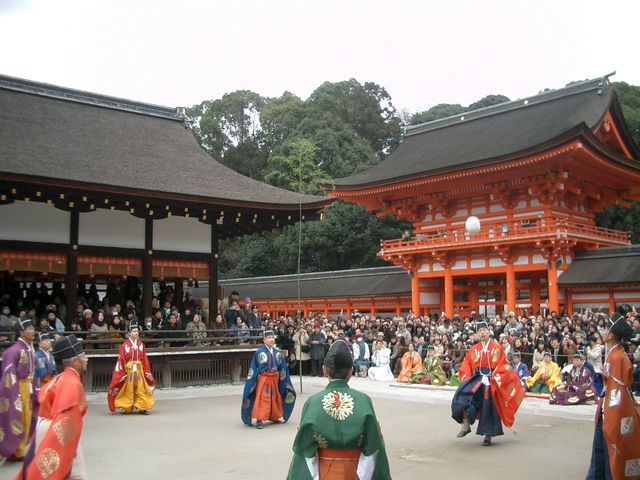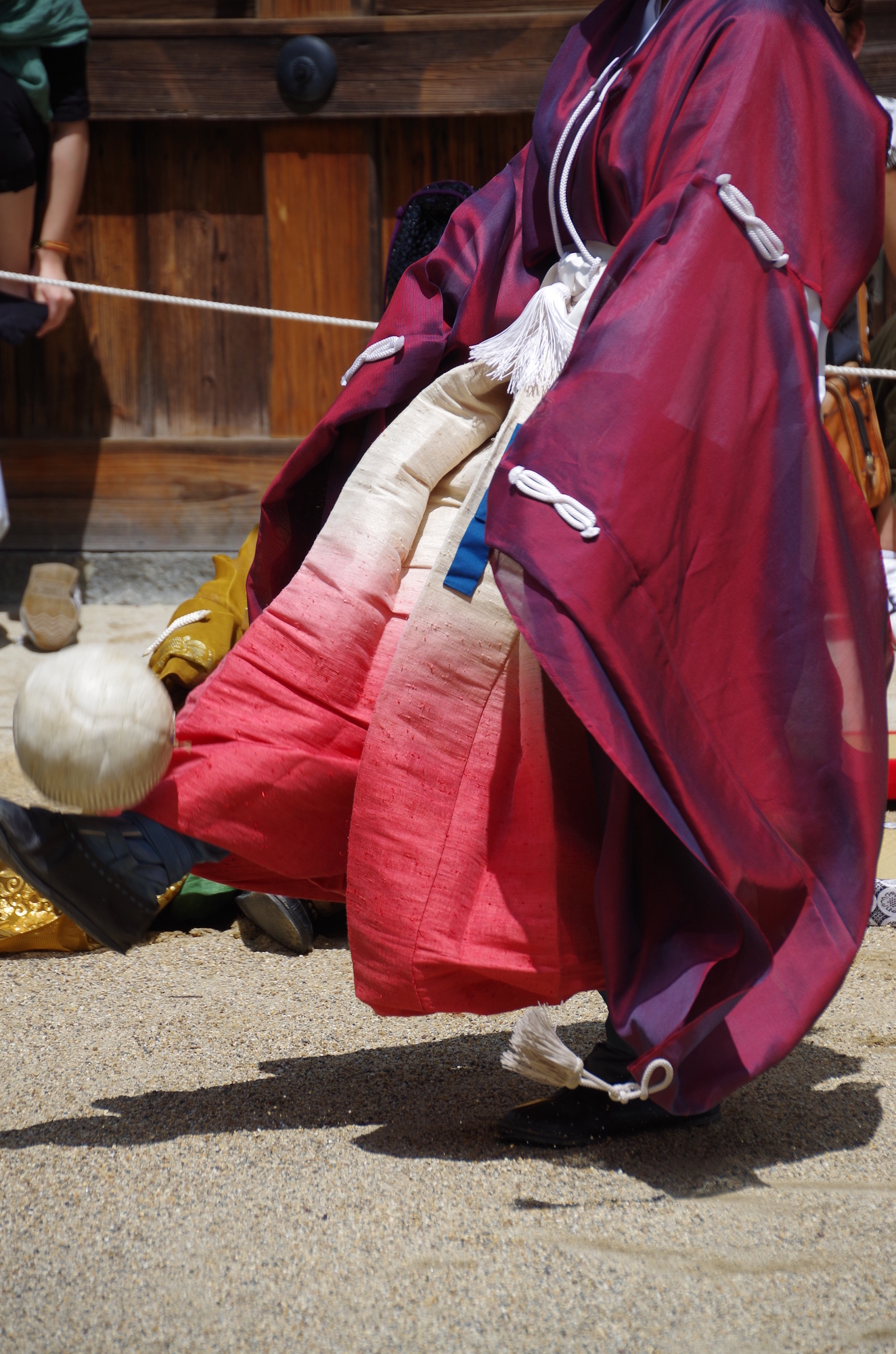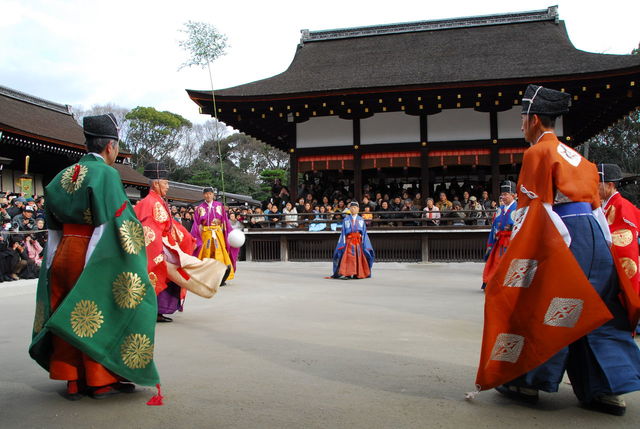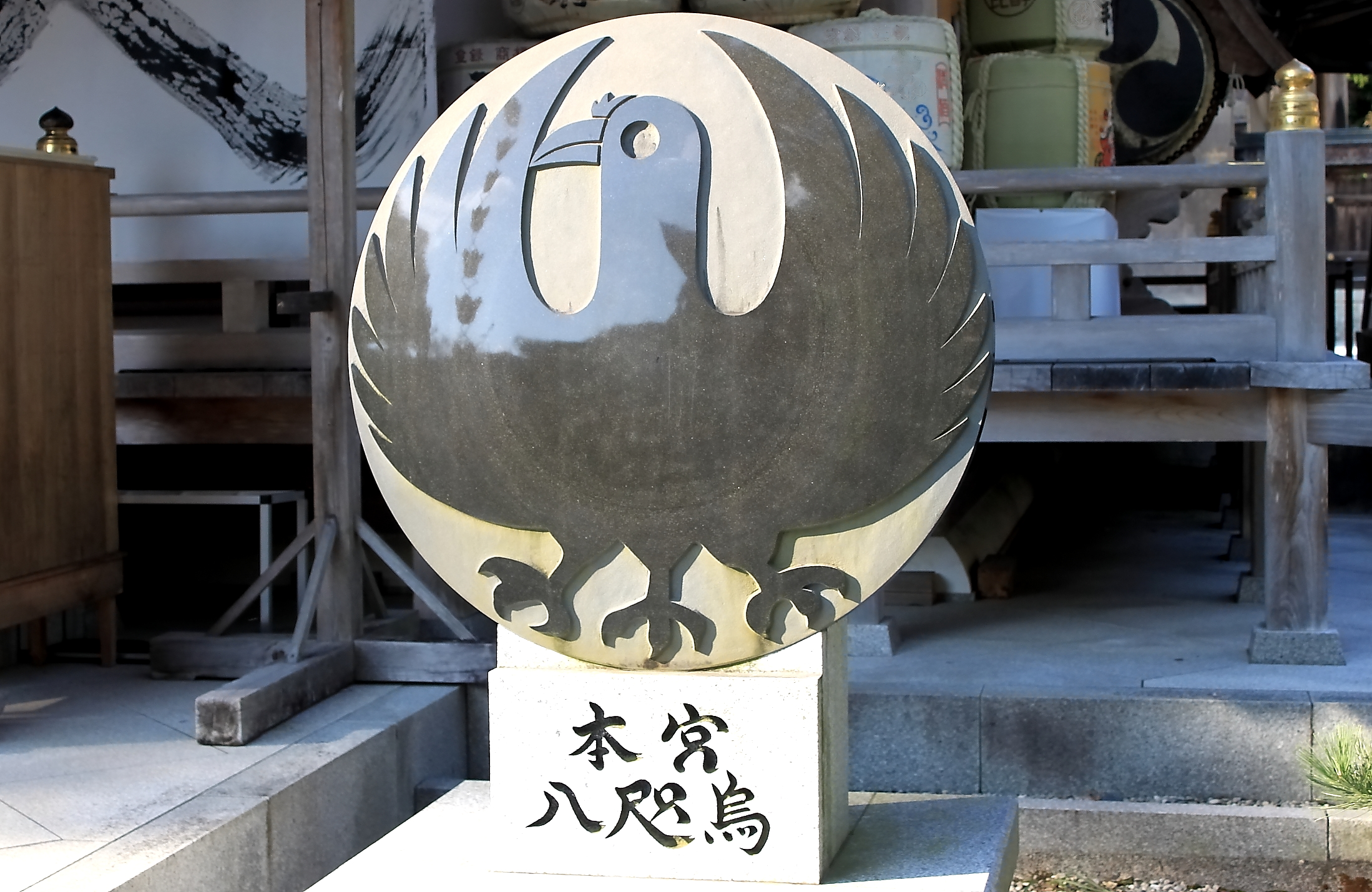In Japan, there will be big sports events like the Rugby World Cup in 2019 and Tokyo Olympics and Paralympics in 2020. We will introduce some sports that either have their roots in Japan, or were introduced to Japan and have gained popularity.
Kemari, a traditional courtly kick-ball game

Kemari Hajime provided by Kamomioya-jinja Shrine (Shimogamo-jinja Shrine)
Was Kemari behind the Taika Reform?
Kemari, also called Shukiku or Kuemari, was introduced from China and is a ball game in which players keep passing a ball made of deerskin to the next player by kicking it while houting “Ya”, “Ari” or “Ou” on a field called Shihon-kakari, where four trees (a cherry, willow, maple and pine) are placed in four corners of the field.
According to the entry for January of 644 in Volume 24 of the Nihon shoki (Chronicles of Japan), Kemari is described in the following scene: “When Prince Naka no Oe was playing a ball game called 打毱 (Mariuchi or Chokyu) with others, his leather shoe dropped off while kicking the ball”. This episode describes how Prince Naka no Oe and Nakatomi no Kamatari became close to each other: when Prince Naka no Oe kicked a ball under an elm (keyaki) tree at Hoko-ji Temple (present-day Asuka-dera Temple) in Asuka (Nara Prefecture), his shoe came off while kicking the ball and Nakatomi no Kamatari, who was playing the ball game with the Prince, picked it up and returned it to him. There are two theories about the ball game mentioned here. The first theory is that it was Chokyu, a hockey-type ball game in which players hit a ball with a stick. The second one suggests Mariuchi is a precursor to Kemari based on the description of the Prince’s shoe coming off with the ball. Currently, the second theory is used when exploring the beginnings of Kemari in Japan. After Prince Naka no Oe and Nakatomi no Kamatari became friends following this event, they went on to perform the great task of the Taika Reforms together.

There is a description of a ball game called Kemariein the Honcho Gatsuryo a commentary on annual events at the Imperial Court. The ball game mentioned was held on May 5 in 701, demonstrating that Kemari was introduced to Japan sometime between the end of the Asuka Period and the early Nara Period.
During the reigns of Emperor Daigo and Emperor Murakami, Kemari was often practiced in the Eastern Garden of the Jijuden Hall at the Imperial Court, and went on to become popular among the court nobles during the reign of Emperor Ichijo. In the late Heian Period, Kemari professionals appeared and became well-known all over the capital, including individuals such as Fujiwara no Narimichi, “The Saint of the Ball” and Nanba Yorisuke Nanba (the fourth son of Tadanori, a chief counselor of state), who went on to become founder of the two Marido (art of Kemari) families, the Nanba and the Asukai families, and who won the Cloistered Emperor Goshirakawa’s favor and was praised as “the greatest Kemari player”. It is also said that even retired Emperor Gotoba himself enjoyed Kemari.
In the Kamakura Period, frequent Kemari meets were held because Minamoto no Yoriie, the second shogun of the Kamakura bakufu, was especially fond of Kemari. Both the Nanba and the Asukai families promoted Marido in Kamakura, and as a result, various systems of Kemari were put into place. After both families were approved as masters of Marido, the schools named after them and as well as others such as the Mikohidari and Minase schools were established. Court nobles who belonged to these schools were called Mariashi (Kemari player). From the Muromachi Period, since both Yoshimitsu Ashikaga, the third shogun, and Yoshimasa Ashikaga, the eighth shogun, actively practiced Kemari, it became popular among samurai families, going on to become a necessary part of samurai cultural education along with Japanese poetry and the tea ceremony.
During the Sengoku Period, the popularity of Kemari appears to have cooled down due to the growing popularity of Sumo (Japanese-style wrestling). However, descriptions such as the one in the Saikaku oridome (a book describing townspeople’s life and thinking) written by Saikaku Ihara indicate the revival of Kemari around the Kansai area in the Edo Period.
Kemari Dedicated at Shrines
In premodern times, on January 4 every year Mari hajime (first Kemari match of the year) were conducted by members of the Nanba and the Asukai families. As Kemari was a game popular with the Imperial family and court nobles, it is still performed at shrines around Kyoto and in other areas as an offering.
For example, Kemari hajime is held on January 4 every year at Kamomioya-jinja Shrine (Shimogamo-jinja Shrine) in Kyoto. Watching Kemari players skillfully kicking balls while wearing traditional clothes and leather shoes for court nobles such as suikan (plain garments), hakama (formal pleated pants) and eboshi (hats) is nothing short of spectacular. Along with a wave of modernization in the Meiji Period, there was concern that ancient and traditional performing arts including Kemari hajime would gradually die out. At that time, Emperor Meiji issued an imperial edict to preserve Kemari, and the Kemari Preservation Society was established with an imperial donation in 1903. Thanks to this, Kemari persists as a New Year’s shinto ritual to this day.

Kemari Hajime provided by Kamomioya-jinja Shrine (Shimogamo-jinja Shrine)
In addition to this, Kemari is also performed at Shiramine-jingu Shrine in Kyoto on April 14 and July 7 every year by the Kemari Preservation Society. The Sei-daimyojin deity, enshrined in an auxiliary shrine of the Shiramine-jingu Shrine, is the guardian deity of Kemari, and was originally enshrined at the Asukai family’s residence. Today, Sei-daimyojin is thought to be the god of ball games and sports, and there is a Kemari monument within the shrine which has gained a following as a prayer spot among people looking to improve in ball games.
Other than that, Kemari events are also held at Fujinomori-jinja Shrine (Kyoto Prefecture), Tanzan-jinja Shrine (Nara Prefecture), Hirano-jinja Shrine (Shiga Prefecture), Kotohira-gu Shrine (Kagawa Prefecture), and many other locations.Kemari has found a place in many shrines around the Kansai area through the efforts of the Kemari Preservation Society in recent years.
Is Yatagarasu the God of Ball Games?
The Deep Relationship between Yatagarasu and Soccer

Yatagarasu
Fujiwara no Narimichi, a Kemari expert, made over 50 pilgrimages to Kumano in order to pray for greater skill in Kemari. One story about him in Volume 11 of the Kokon chomon ju (A Collection of Tales Past and Present) relates that Narimichi dedicated a special move called Ushiro mari (kicking the ball backwards) to the deity of Kumano . Kemari, like soccer and rugby, is a game of squaring off against other players, matching skill with skill.
Incidentally, the logo of the Japan Football Association (JFA) and the emblem of Japan’s national soccer team is Yatagarasu, a sacred crow with three legs. Yatagarasu is thought to be a messenger of Ketsumimiko no okami (Susanoo no mikoto), who is one of the main enshrined deities at Kumano. Moreover, Yatagarasu is also known to have a deep connection to the afore-mentioned Kamomioya-jinja Shrine because Yatagarasu is thought to be an avatar of the deity Kamotaketsunumi no mikoto, the god who established ancient Kyoto. At the same time, a god called Kantama no miko, enshrined at the Sawata-sha Shrine, is worshiped as the god of ball games since the name of the god contains the word tama (twhich can also mean “ball”). Furthermore, the horse path of Tadasu-no-mori forest connected to the shrine is considered a sacred place for rugby players in Japan. This is because rugby was first played in the Kansai area by a team from the Number Three High School (present-day Kyoto University) in 1910.
Yatagarasu is mentioned also in the Kojiki (The Records of Ancient Matters) and the Nihon shoki. The most famous episode is when it guided the legendary Emperor Jinmu from Kumano Province to Kashihara in Yamato Province during his Eastern Conquest.. Following from this, Yatagarasu has been worshiped as the god of guidance. The JFA logo, suggested by Chinese classical literary scholar Tairei Uchino and designed by sculptor Jitsuzo Hinago, was adopted in 1931 by the Dainihon Shukyu Kyokai (predecessor to the JFA). We all hope Japan’s national soccer team and its players will follow in the footsteps of “the saint of the ball” Fujiwara no Narimichi and follow the path to victory like “the god of guidance” Yatagarasu.
Yorio FUJIMOTO
Research
Modern History of Shinto, Shinto Edification, Sociology of Religion
Papers
Mirror and Honesty -Education for Human Nature in Shinto Virtues and Words-(2025/08/01)
Nezu Shrine Small Thought (Nezu Jinja Small Thought)(2024/12/30)

